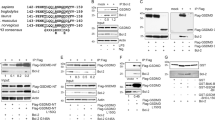Abstract
An apoptotic signal triggered by cell surface death receptors is disseminated to intracellular compartments through protein–protein interactions mediated by conserved domains such as the death effector domain (DED). A unique family of single DED-containing proteins, including DEDD and DEDD2, is targeted to the nucleolus. However, the role of DEDD/DEDD2 in apoptosis remains less understood. Here we show that DEDD and DEDD2 are highly conserved in diverse species, and that they are potent inducers of apoptosis in various cell types. Deletion analysis indicates that both the N-terminal DED domain and the C-terminal region of DEDD2 can induce apoptosis. The cell death activity of this family appears to be related to their nuclear localization. DEDD and DEDD2 bind to two tandem DED-containing caspases, caspase -8 and -10, that are engaged by death receptors. Consistent with the nuclear localization of this family, caspase-8 translocates to the nucleus during CD95-induced apoptosis. DEDD and DEDD2 also readily associate with themselves and with each other. These results suggest that DEDD and DEDD2 may be important mediators for death receptors and that they may target caspases to the nucleus.
This is a preview of subscription content, access via your institution
Access options
Subscribe to this journal
Receive 50 print issues and online access
$259.00 per year
only $5.18 per issue
Buy this article
- Purchase on Springer Link
- Instant access to full article PDF
Prices may be subject to local taxes which are calculated during checkout




Similar content being viewed by others
References
Ashkenazi A and Dixit VM . (1998). Science, 281, 1305–1308.
Chang HY and Yang X . (2000). Microbiol. Mol. Biol. Rev., 64, 821–846.
Martin DA, Siegel RM, Zheng L and Lenardo MJ . (1998). J. Biol. Chem., 273, 4345–4349.
Muzio M, Stockwell BR, Stennicke HR, Salvesen GS and Dixit VM (1998). J. Biol. Chem., 273, 2926–2930.
Roth W, Stenner-Liewen F, Pawlowski K, Godzik A and Reed JC (2002). J Biol. Chem., 277, 7501–7508.
Schickling O, Stegh AH, Byrd J and Peter ME . (2001). Cell Death Differ., 8, 1157–1168.
Stegh AM, Schickling O, Ehret A, Scaffidi C, Peterhansel C, Hofmann TG, Grummt I, Krammer PH and Peter ME (1998). EMBO. J., 17, 5974–5986.
Yang X, Chang HY and Baltimore D . (1998a). Mol. Cell, 1, 319–325.
Yang X, Chang HY and Baltimore D (1998b). Science, 281, 1355–1357.
Zhan Y, Hegde R, Srinivasula SM, Fernandes-Alnemri T and Alnemri ES . (2002). Cel. Death Differ., 9, 439–447.
Zhou BB, Li H, Yuan J and Kirschner MW . (1998). Proc. Natl. Acad. Sci. USA, 95, 6785–6790.
Acknowledgements
We thank Vanessa Capacio for excellent technical assistance. Supported by an NIH Cell and Molecular training grant (to AA), a cystic fibrosis foundation fellowship (to JT), and an NIH Grant CA88868.
Author information
Authors and Affiliations
Corresponding author
Rights and permissions
About this article
Cite this article
Alcivar, A., Hu, S., Tang, J. et al. DEDD and DEDD2 associate with caspase-8/10 and signal cell death. Oncogene 22, 291–297 (2003). https://doi.org/10.1038/sj.onc.1206099
Received:
Revised:
Accepted:
Published:
Issue Date:
DOI: https://doi.org/10.1038/sj.onc.1206099
Keywords
This article is cited by
-
JMJD6 functions as an oncogene and is associated with poor prognosis in esophageal squamous cell carcinoma
BMC Cancer (2023)
-
Death effector domain-containing protein induces vulnerability to cell cycle inhibition in triple-negative breast cancer
Nature Communications (2019)
-
Hot water extract of Agaricus blazei Murrill specifically inhibits growth and induces apoptosis in human pancreatic cancer cells
BMC Complementary and Alternative Medicine (2018)
-
PTHrP attenuates osteoblast cell death and apoptosis induced by a novel class of anti-cancer agents
Endocrine (2016)
-
Changes in Apoptotic Gene Expression in Lymphocytes from Rheumatoid Arthritis and Systemic Lupus Erythematosus Patients Compared with Healthy Lymphocytes
Journal of Clinical Immunology (2010)



